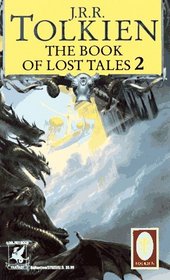Cherol O. (bottleredhead) reviewed The Book of Lost Tales, Part Two (The History of Middle-Earth, Vol. 2) on + 3 more book reviews
Helpful Score: 1
Though they cover a broadly similar history, the Tales are very different from The Silmarillion. Firstly the Tales are more complex and detailed, written in an archaic style and include many obsolete words and phrases. Secondly, the interaction between the different elf-races is profoundly different from the Silmarillion: The exiled Noldoli (or "Gnomes", the Noldor of the later histories) suffer decisive defeat much earlier and become slaves of the enemy they had sought to punish. When Thingol feels disdain for Beren, it is because the latter is a gnome (not a mortal human) and therefore a thrall of Melko.
The book is a collection of smaller stories, all with similar themes and complexity.
1. "The Tale of Tinúviel" first version of the tale of Beren and Lúthien
2. "Turambar and the Foalókë" first version of the Túrin saga
3. "The Fall of Gondolin" the only full narrative of the Fall of Gondolin
4. "The Nauglafring" a story which was "lost", in that it never was rewritten in full, and was mostly left out of the later Silmarillion.
5. "The Tale of Eärendel" the only full narrative of Eärendil's travels
6. "The History of Eriol or Ælfwine and the End of the Tales" an essay about the changes in the framework, and the "unwritten" tales.
The book is a collection of smaller stories, all with similar themes and complexity.
1. "The Tale of Tinúviel" first version of the tale of Beren and Lúthien
2. "Turambar and the Foalókë" first version of the Túrin saga
3. "The Fall of Gondolin" the only full narrative of the Fall of Gondolin
4. "The Nauglafring" a story which was "lost", in that it never was rewritten in full, and was mostly left out of the later Silmarillion.
5. "The Tale of Eärendel" the only full narrative of Eärendil's travels
6. "The History of Eriol or Ælfwine and the End of the Tales" an essay about the changes in the framework, and the "unwritten" tales.




